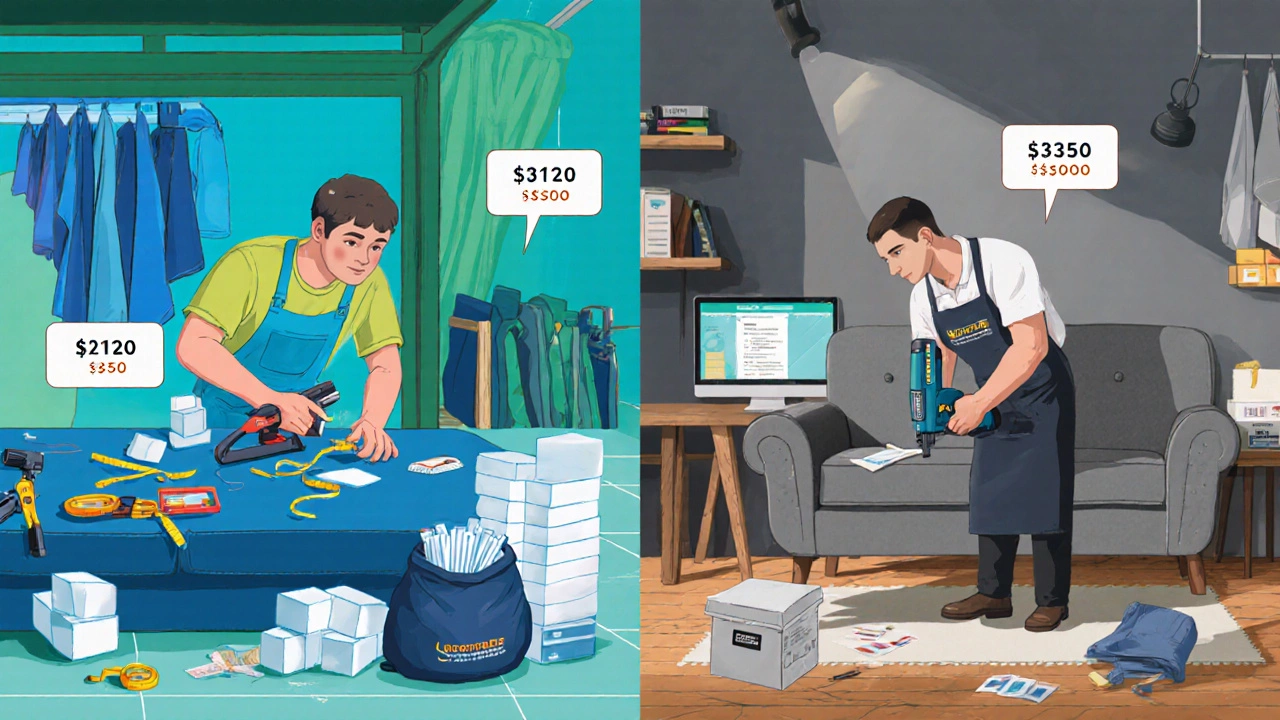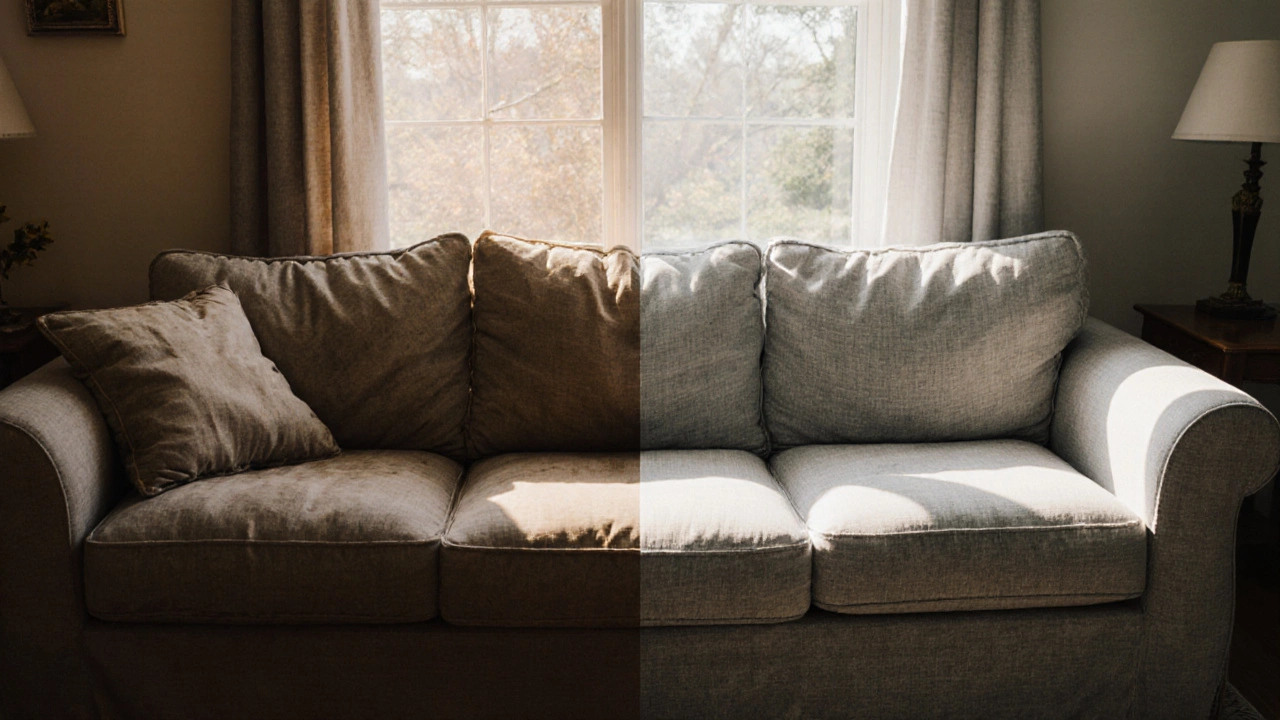Sofa Re-cushioning Cost Estimator
Estimated Cost Range
Click "Estimate Cost" to see your personalized estimate.
DIY Cost
$120 - $350
Includes materials onlyProfessional Cost
$350 - $900
Includes labor and materialsAverage Savings
$230 - $550
By choosing DIYQuick Takeaways
- Professional re‑cushioning typically runs $350‑$900 per sofa, depending on size and material.
- DIY projects can drop the price to $120‑$350, but you need the right tools and a bit of patience.
- Foam density, fabric choice, and labor hours are the three biggest cost drivers.
- Getting three quotes and checking contractor reviews saves both money and headaches.
- Watch out for hidden fees like foam removal, upholstery trim, and travel surcharge.
What is Sofa Re‑cushioning?
When a sofa loses its springy feel or the cushions sag, the solution isn’t always to buy a new piece. Sofa Re‑cushioning is the process of removing old padding, replacing it with fresh foam or fiber, and then re‑upholstering the cushion covers. It gives an existing sofa a almost‑new comfort level while preserving the style you love.
What Drives the Price?
Three core elements dictate the final bill:
- Foam type and density - Higher‑density foam (e.g., 2.5lb/ft³) feels firmer and lasts longer, but it costs more per board foot.
- Upholstery fabric - Luxury fibers like velvet or leather carry a premium, whereas polyester blends are budget‑friendly.
- Labor hours - Removing old material, cutting new foam, and stitching fabric are labor‑intensive tasks.
Other factors that add dollars include the sofa’s size (sectional vs. loveseat), the condition of the frame, and any custom trim work.

DIY vs. Professional: Cost Breakdown
| Item | DIY Approx. | Professional Approx. |
|---|---|---|
| Foam (per seat) | $45‑$80 | $45‑$80 (included) |
| Fabric (per yard) | $12‑$40 | $12‑$40 (included) |
| Tools & Supplies | $30‑$70 (one‑time) | - |
| Labor | 0h (your time) | $200‑$500 |
| Travel/Quote Fee | 0$ | $0‑$50 |
| Total per sofa | $120‑$350 | $350‑$900 |
These numbers are based on average NewZealand market rates in 2025. Prices can swing higher for corner sections, custom tufting, or premium leather.
Material Choices and Their Prices
Below are the most common cushioning options and what you can expect to pay.
- High‑density foam is a firm, resilient material that retains shape for 8‑10years. Approx. $1.20‑$1.80 per board foot.
- Memory foam conforms to body heat, offering a plush feel but can sag faster under heavy use. Around $1.50‑$2.30 per board foot.
- Fiberfill (polyester) soft, inexpensive, often blended with foam for a layered cushion. $0.60‑$0.90 per board foot.
- Down/blend luxury option that feels airy but requires a protective foam core. $2.00‑$3.50 per board foot.
For upholstery fabric, a 2‑yard roll of durable polyester costs about $12‑$20, while a high‑end leather hide can exceed $80 per square meter.
How to Get Accurate Quotes
Even if you lean DIY, a professional quote helps benchmark your budget.
- Measure each cushion seat, back, and arm width, then record the depth.
- Take clear photos of the existing fabric, seams, and any damage.
- Contact at least three upholstery contractors in Wellington. Provide the measurements and photos; ask for a line‑item breakdown (foam, fabric, labor).
- Ask whether the quote includes removal of old padding, disposal fees, and travel costs.
- Check reviews on local forums or Google; look for mentions of “transparent pricing” and “on‑time delivery”.
Most contractors will give a free on‑site estimate, but some may charge a modest $30‑$50 travel fee-factor that into your comparison.
Hidden Costs and Common Pitfalls
When the bill arrives, a few surprise items can pop up:
- Foam removal - Old foam that’s glued to the frame may need a specialist tool, adding $30‑$80.
- Trim replacement - If the sofa’s piping or decorative trim is damaged, replacing it costs $15‑$40 per meter.
- Travel surcharge - Contractors serving remote suburbs often tack on $0.20 per kilometer.
- Fabric waste - Pattern‑matched fabric may require extra yards; plan for a 10‑15% waste factor.
To avoid sticker shock, ask the contractor to list every potential extra before work begins.
Checklist Before You Start
- ✅ Verify the sofa frame is solid; cracked wood adds repair cost.
- ✅ Decide on foam density based on intended use (high‑traffic rooms need firmer foam).
- ✅ Choose upholstery fabric that matches both style and durability needs.
- ✅ Gather tools if DIY: staple gun, electric upholstery needle, scissors, measuring tape.
- ✅ Get at least three written quotes with line‑item pricing.
- ✅ Set a budget buffer of 10‑15% for unexpected expenses.
Frequently Asked Questions
How long does a professional re‑cushioning job usually take?
Most contractors finish a standard three‑seat sofa in 4‑6hours, meaning a single‑day visit. Larger sectionals can require 1‑2days.
Can I keep the original cushion covers?
If the fabric is still in good condition and matches your new padding, you can reuse it. However, most people replace both for a fresh look, especially if the old fabric is faded.
Is it worth re‑cushioning an older sofa?
If the frame and springs are solid, re‑cushioning can extend a sofa’s life by 5‑10years and save the expense of a brand‑new piece, which often costs $1,200‑$3,000 for comparable quality.
What foam density should I choose for a family room?
A density of 2.0-2.5lb/ft³ balances comfort and durability for daily use. Higher density (2.8lb/ft³) is best for high‑traffic areas like a kids’ playroom.
Do I need a special upholstery needle for DIY?
A heavy‑duty electric upholstery needle (often sold as a "U‑needle") makes stitching through thick foam and fabric much easier. They cost around $25‑$40 and are a worthwhile investment for occasional projects.
